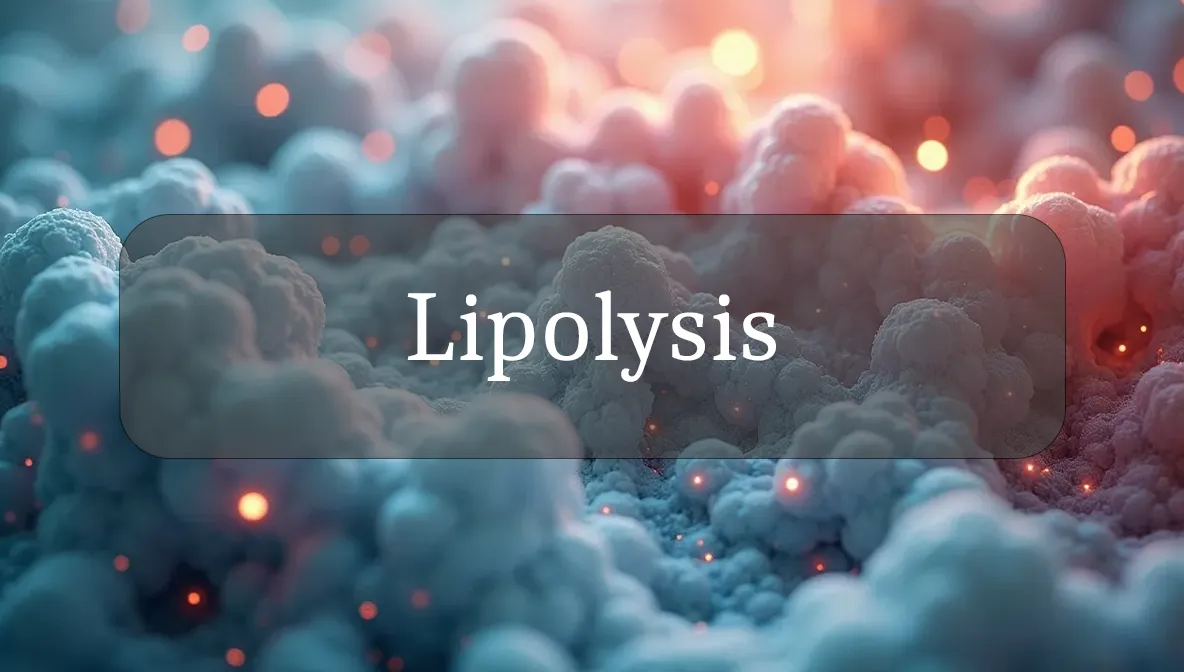Body’s Fat-Burning Engine
Lipolysis is the process your body uses to break down stored fats into energy, acting like a power switch to fuel your activities when needed. This metabolic pathway is key to managing energy balance and keeping you active and healthy. Let’s explore what lipolysis is, its role in your wellness, and how to support it for daily vitality.
Identity and Function
Lipolysis is the biochemical breakdown of triglycerides (stored fats) in fat cells (adipocytes) into glycerol and free fatty acids. It occurs primarily in adipose tissue and is triggered by hormones like adrenaline, glucagon, or cortisol, especially during fasting, exercise, or stress. The process involves enzymes like hormone-sensitive lipase and adipose triglyceride lipase. Free fatty acids are released into the blood to provide energy for muscles, the heart, and other tissues, while glycerol can be used to make glucose in the liver.
Biological Role and Health Impact
Lipolysis is essential for keeping your body energized and balanced:
- Energy Supply: It provides fatty acids as fuel during exercise, fasting, or low-carb diets, keeping you active and alert.
- Blood Sugar Support: Glycerol from lipolysis can be converted to glucose (gluconeogenesis), stabilizing blood sugar during fasting or intense activity.
- Weight Management: By mobilizing stored fat, lipolysis helps regulate body fat levels, supporting a healthy weight when balanced with fat storage.
- Metabolic Flexibility: It allows your body to switch between burning carbs and fats, optimizing energy use based on your needs.
- Heart and Muscle Health: Fatty acids fuel the heart and skeletal muscles, supporting endurance and cardiovascular function.
By efficiently breaking down fats, lipolysis supports energy, metabolism, and physical performance.
Production and Sources
Lipolysis occurs naturally, driven by your body’s energy demands:
- How It Works: When energy is needed (e.g., during exercise or fasting), hormones signal fat cells to activate lipolysis. Fatty acids and glycerol are released into the bloodstream for use by tissues like muscles or the liver.
- Dietary Influence: Low-carb or high-fat diets (e.g., keto) increase lipolysis to meet energy needs, while high-carb diets reduce it as glucose is prioritized. Protein (meat, eggs) supports hormone production that triggers lipolysis.
- Key Nutrients: Magnesium (nuts, spinach) and B vitamins (B3 in fish, B6 in bananas) support enzymes and hormones involved in lipolysis. Caffeine (coffee, tea) can mildly stimulate the process.
- No External Sources: Lipolysis is an internal process; you don’t consume its products directly.
A balanced diet and active lifestyle promote efficient lipolysis.
Signs of Imbalance
Imbalances in lipolysis can lead to metabolic or health issues:
- Impaired Lipolysis:
- Fatigue or low endurance during exercise, as the body struggles to access fat stores for energy.
- Weight gain or difficulty losing fat, often linked to insulin resistance or hormonal issues (e.g., hypothyroidism).
- Excess Lipolysis:
- Unintended weight loss or muscle wasting, seen in chronic stress, starvation, or conditions like diabetes (ketoacidosis).
- High blood levels of fatty acids or ketones, causing symptoms like nausea, bad breath, or, in severe cases, acidosis.
- Metabolic Disorders:
- Symptoms like high triglycerides or insulin resistance in metabolic syndrome, reflecting dysregulated fat metabolism.
If you notice persistent fatigue, unexplained weight changes, or metabolic symptoms, see a doctor for tests like blood lipid panels, glucose levels, or hormone profiles.
Supporting Healthy Function
To keep lipolysis balanced and energy-efficient:
- Exercise Regularly: Aim for 30–60 minutes most days, mixing cardio (running, cycling) and strength training (weights) to stimulate lipolysis and burn fat.
- Eat a Balanced Diet: Include moderate protein (chicken, tofu), healthy fats (avocado, nuts), and complex carbs (quinoa, veggies) to balance energy sources and avoid insulin spikes that suppress lipolysis.
- Time Your Meals: Consider intermittent fasting or spacing meals to allow lipolysis to kick in between meals, but consult a doctor if you have medical conditions.
- Stay Hydrated: Drink 8–12 cups of water daily to support metabolism and fat breakdown.
- Manage Stress: Chronic stress raises cortisol, which can overdrive lipolysis and lead to fat storage in the abdomen. Try yoga, meditation, or deep breathing.
Safety and Precautions
Lipolysis is a natural process, but health conditions or lifestyle factors require care:
- Medical Conditions: Diabetes, obesity, or hormonal disorders (e.g., Cushing’s syndrome) can disrupt lipolysis, requiring medical management.
- Medications: Drugs like beta-blockers or insulin can affect fat breakdown. Use as prescribed and discuss side effects with your doctor.
- Hormonal Factors: Thyroid issues or menopause can alter lipolysis rates. Monitor symptoms like weight changes with your doctor.
- Extreme Diets: Very low-carb or ketogenic diets boost lipolysis but may cause side effects like keto flu or kidney strain in some people. Consult a dietitian.
- Overtraining: Excessive exercise without recovery can spike cortisol, disrupting lipolysis balance. Rest adequately and vary workouts.
If you have weight issues, fatigue, or metabolic concerns, consult a healthcare provider for tests like lipid panels or hormone checks.
Fun Fact
Did you know lipolysis can power a marathon? During long runs, your body taps into fat stores via lipolysis, providing enough energy to keep you going for miles without a snack!
Citations
- National Institutes of Health (NIH): Lipolysis and Fat Metabolism.
- Mayo Clinic: Metabolism and Weight Management.
- Cleveland Clinic: Understanding Lipid Metabolism.
- American Diabetes Association: Fat Breakdown and Energy Balance.
- Journal of Lipid Research: Lipolysis Pathways and Health (2020).

